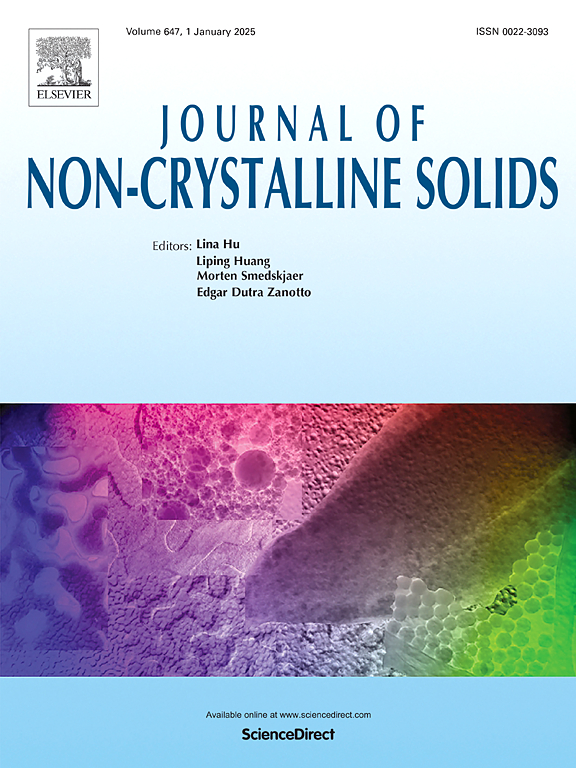纳米压痕蠕变过程中zr基金属玻璃的结构非均质响应及STZ演化
IF 3.5
3区 材料科学
Q1 MATERIALS SCIENCE, CERAMICS
引用次数: 0
摘要
采用纳米压痕法研究了大块金属玻璃Zr41.2Ti13.8Cu12.5Ni10Be22 (Zr-BMG)的流变行为。首先,对Zr-BMG进行了不同加载速率下的纳米压痕试验。然后采用Maxwell-Voigt模型对蠕变行为进行建模,分离蠕变过程中的粘弹性变形和粘塑性变形进行分析,计算蠕变过程中的延迟谱。研究发现,在纳米压痕蠕变过程中,结构非均质性在纳米尺度上是动态演化的。最后,采用应变率敏感性(SRS)方法计算了蠕变过程中剪切过渡区(STZ)的大小。结果表明,在较高加载速率下,粘弹性单元不能完全松弛,导致粘塑性变形过渡;Zr-BMG在高应变速率下具有较强的变形抗力,通常导致较小的STZ。此外,STZ更容易被激活并演变为对外界刺激的结构非均质性响应,材料表现出更明显的蠕变流动性。压痕蠕变机制是由于Zr-BMG中微剪切域的变形,导致缺陷的激活和扩展,最终不可逆地合并成更大的缺陷,揭示了局部原子重排和扩散的过程。本文章由计算机程序翻译,如有差异,请以英文原文为准。
The structural heterogeneity response and the STZ evolution in Zr-based metallic glass during nanoindentation creep
In this paper, the rheological behavior of the bulk metallic glass Zr41.2Ti13.8Cu12.5Ni10Be22 (Zr-BMG) was investigated by nanoindentation. Firstly, nanoindentation tests were conducted on Zr-BMG at different loading rates. Then the Maxwell-Voigt model was employed to model the creep behavior, the viscoelastic and viscoplastic deformations during the creep were separated to analyze, and the delay spectrum during the creep process was calculated. It was found that structural heterogeneity evolves dynamically at the nanoscale during nanoindentation creep. Finally, the size of the shear transition zone (STZ) during creep was calculated by the strain rate sensitivity (SRS) method. The results show that at higher loading rates, the viscoelastic units cannot fully relax, leading to transition into viscoplastic deformation. Zr-BMG has stronger deformation resistance at higher strain rates, which usually leads to a smaller STZ. Furthermore, STZ is more easily activated and evolves into a response of structural heterogeneity to external stimuli, and the material exhibits more obvious creep fluidity. The indentation creep mechanism is due to the deformation of the micro-shear domains in Zr-BMG, leading to the activation and expansion of defects, which ultimately irreversibly merge into larger defects, revealing the process of local atomic rearrangement and diffusion.
求助全文
通过发布文献求助,成功后即可免费获取论文全文。
去求助
来源期刊

Journal of Non-crystalline Solids
工程技术-材料科学:硅酸盐
CiteScore
6.50
自引率
11.40%
发文量
576
审稿时长
35 days
期刊介绍:
The Journal of Non-Crystalline Solids publishes review articles, research papers, and Letters to the Editor on amorphous and glassy materials, including inorganic, organic, polymeric, hybrid and metallic systems. Papers on partially glassy materials, such as glass-ceramics and glass-matrix composites, and papers involving the liquid state are also included in so far as the properties of the liquid are relevant for the formation of the solid.
In all cases the papers must demonstrate both novelty and importance to the field, by way of significant advances in understanding or application of non-crystalline solids; in the case of Letters, a compelling case must also be made for expedited handling.
 求助内容:
求助内容: 应助结果提醒方式:
应助结果提醒方式:


